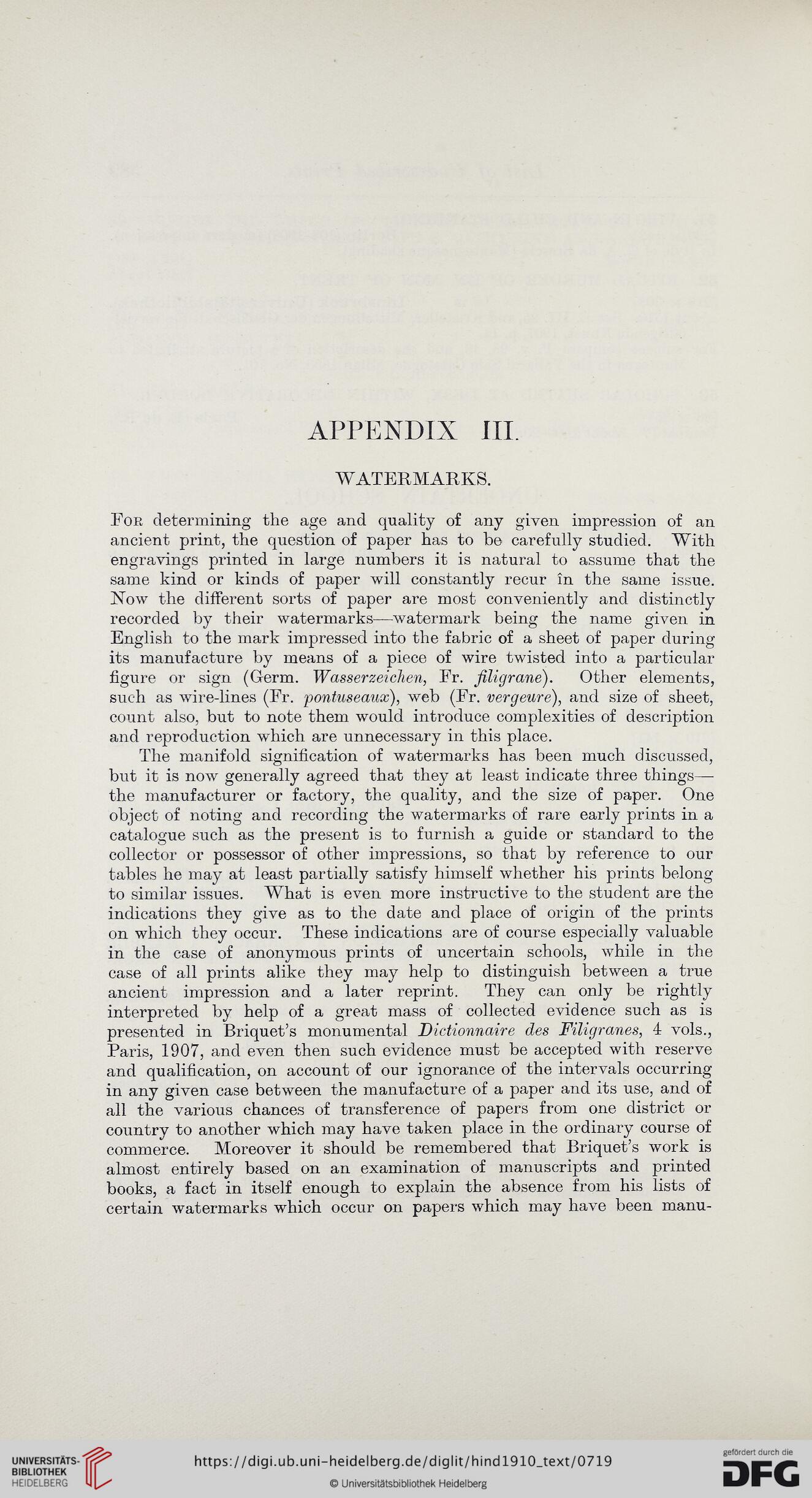APPENDIX III.
WATERMARKS.
For determining the age and quality of any given impression of an
ancient print, the question of paper has to be carefully studied. With
engravings printed in large numbers it is natural to assume that the
same kind or kinds of paper will constantly recur in the same issue.
Now the different sorts of paper are most conveniently and distinctly
recorded by their watermarks—watermark being the name given in
English to the mark impressed into the fabric os a sheet of paper during
its manufacture by means of a piece of wire twisted into a particular
figure or sign (Germ. Wasserzeichen, Fr. siligrane). Other elements,
such as wire-lines (Fr. pontuseaux), web (Fr. vergeure), and size os sheet,
count also, but to note them would introduce complexities of description
and reproduction which are unnecessary in this place.
The manifold signification of watermarks has been much discussed,
but it is now generally agreed that they at least indicate three things-
the manufacturer or factory, the quality, and the size of paper. One
object of noting and recording the watermarks of rare early prints in a
catalogue such as the present is to furnish a guide or standard to the
collector or possessor of other impressions, so that by reserence to oui’
tables he may at least partially satissy himself whether his prints belong
to similar issues. What is even more instructive to the student are the
indications they give as to the date and place of origin of the prints
on which they occur. These indications are os course especially valuable
in the case os anonymous prints os uncertain schools, while in the
case of all prints alike they may help to distinguish between a true
ancient impression and a later reprint. They can only be rightly
interpreted by help of a great mass of collected evidence such as is
presented in Briquet’s monumental Dictionnaire des Filigranes, 4 vols.,
Paris, 1907, and even then such evidence must be accepted with reserve
and qualification, on account of our ignorance os the intervals occurring
in any given case between the manufacture of a paper and its use, and of
all the various chances os transserence of papers from one district or
country to another which may have taken place in the ordinary course of
commerce. Moreover it should be remembered that Briquet’s work is
almost entirely based on an examination of manuscripts and printed
books, a fact in itsels enough to explain the absence from his lists of
certain watermarks which occur on papers which may have been manu-
WATERMARKS.
For determining the age and quality of any given impression of an
ancient print, the question of paper has to be carefully studied. With
engravings printed in large numbers it is natural to assume that the
same kind or kinds of paper will constantly recur in the same issue.
Now the different sorts of paper are most conveniently and distinctly
recorded by their watermarks—watermark being the name given in
English to the mark impressed into the fabric os a sheet of paper during
its manufacture by means of a piece of wire twisted into a particular
figure or sign (Germ. Wasserzeichen, Fr. siligrane). Other elements,
such as wire-lines (Fr. pontuseaux), web (Fr. vergeure), and size os sheet,
count also, but to note them would introduce complexities of description
and reproduction which are unnecessary in this place.
The manifold signification of watermarks has been much discussed,
but it is now generally agreed that they at least indicate three things-
the manufacturer or factory, the quality, and the size of paper. One
object of noting and recording the watermarks of rare early prints in a
catalogue such as the present is to furnish a guide or standard to the
collector or possessor of other impressions, so that by reserence to oui’
tables he may at least partially satissy himself whether his prints belong
to similar issues. What is even more instructive to the student are the
indications they give as to the date and place of origin of the prints
on which they occur. These indications are os course especially valuable
in the case os anonymous prints os uncertain schools, while in the
case of all prints alike they may help to distinguish between a true
ancient impression and a later reprint. They can only be rightly
interpreted by help of a great mass of collected evidence such as is
presented in Briquet’s monumental Dictionnaire des Filigranes, 4 vols.,
Paris, 1907, and even then such evidence must be accepted with reserve
and qualification, on account of our ignorance os the intervals occurring
in any given case between the manufacture of a paper and its use, and of
all the various chances os transserence of papers from one district or
country to another which may have taken place in the ordinary course of
commerce. Moreover it should be remembered that Briquet’s work is
almost entirely based on an examination of manuscripts and printed
books, a fact in itsels enough to explain the absence from his lists of
certain watermarks which occur on papers which may have been manu-




